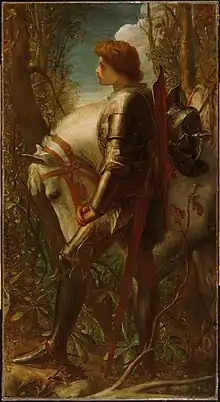
A white knight is a mythological figure and literary stock character. They are portrayed alongside a black knight as diametric opposites. A white knight usually represents a heroic warrior fighting against evil, with the role in medieval literature being represented by a knight-errant.
Mythology
The idea of a positive and negative color symbol being diametrically opposed is very common in ancient mythology, of which the white and black knights are one example, with others including the white horse and black horse from Indo-Aryan mythology.[1] The white color symbolized innocence, illumination, openheartedness, and gladness.[1]
Modern use
The term "white knight" is used in modern-day parlance to mean any kind of savior,[2] although it is also specifically used in a business context to describe a person or corporation that saves another company from a hostile takeover and acquires its assets.[3]
"White knight" is also used in slang to refer to men who are trying to curry the favor of women by protecting them, alongside other, similar terms, such as "simp" or "whipped".[4] The usage of the term implies that these men, when doing nice things for women, are motivated only by sexual desires.[5]
The depiction of a morally pure white person and a nonwhite antagonist has been criticized as a modern use of the white knight trope that perpetuates racist attitudes.[6]
Historical origins
Although the term 'white knight' has taken on a colloquial meaning in modern English, the White Knight was a historical noble title in the peerage of Ireland, first bestowed upon the Fitzgibbon family by King Edward III in 1333 AD.[7] The other two Irish hereditary knighthoods are the Knight of Glin (also called the Black Knight), and the Knight of Kerry (also called the Green Knight).
See also
References
- 1 2 Cirlot, Juan Eduardo (2014). A dictionary of symbols (2nd ed.). New York.: Welcome Rain Publishers. pp. 56–57, 171. ISBN 978-1-56649-054-2. OCLC 772000894.
- ↑ Melillo, Joseph (2004). American slang : cultural language guide to living in the USA. Edward M. Melillo (1st ed.). Seattle, Wash.: Classic Day Pub. p. 359. ISBN 1-59404-017-6. OCLC 57247490.
- ↑ Dickson, Paul (2010). Slang! : the topic-by-topic dictionary of contemporary American lingoes. New York: Pocket Books. p. 74. ISBN 978-0-8027-1849-5. OCLC 761007672.
- ↑ Marcus, Ezra; Bromwich, Jonah Engel (2020-07-07). "A Short History of 'Simp'". The New York Times. ISSN 0362-4331. Retrieved 2021-06-12.
- ↑ Lindsay, Jessica (2020-01-04). "What is simping, and what is a simp?". Metro. Retrieved 2021-06-12.
- ↑ Marchetti, Gina (1993). Romance and the "yellow peril" : race, sex, and discursive strategies in Hollywood fiction. Berkeley: University of California Press. p. 114. ISBN 978-0-520-91462-9. OCLC 45885594.
- ↑ Forester, Henry Rumsey (1852). The pocket peerage of Great Britain and Ireland. p. 88.